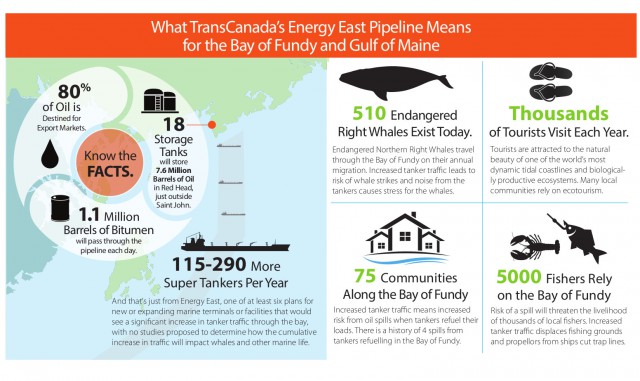Saint John, N.B. – Today the heads of Canada’s leading environmental groups stood alongside First Nations and local fishers on Mispec Beach, New Brunswick near the Bay of Fundy to call for the rejection of the Energy East pipeline and tanker proposal.
Executive directors took a tour on a local fishing boat around eastern Saint John Harbour and Redhead to see firsthand the unique ecosystem and sustainable jobs at risks from TransCanada’s Energy East proposal.
“Energy East would bring almost 300 more tankers to the Bay of Fundy every year, putting whales at risk from propeller strikes and noise pollution,” Tim Gray from Environmental Defence said. “Many of the Bay of Fundy‘s dozen types of whales are highly endangered – heavy tanker traffic or spills will only harm them.”
Noise from traffic from the pipeline project’s estimated 115-290 additional tankers in Saint John would put marine mammals like the endangered North Atlantic right whale in harm’s way. Studies show whales are forced to ‘shout’ over tanker engines and are unable to communicate when noise reaches a certain level.
The Bay of Fundy experiences the world’s largest tides and thick fog, which creates significant additional challenges for emergency responses in the event of a spill.
The Bay of Fundy is an extremely rich ecosystem that harbours a great number of different marine bird species year round. The proposed tanker shipping route traverses eight areas of exceptional international conservation importance for numerous species of marine birds.
Species at risk in the Bay of Fundy region include Red Knot, Roseate Tern, Piping Plover, Harlequin Duck, Yellow Rail, and Short-eared Owl as well as Atlantic Salmon, and Northern Right Whale. These species are already threatened by oil spills, other pollution, disturbance, and fishing activities, as well as ship strikes.
“The Bay of Fundy is a highly sensitive ecosystem, any oil spill would be disastrous,” said Matthew Abbott, of the Conservation Council of New Brunswick. “When spilled, oilsands bitumen forms tar balls that sink, creating a lasting disaster for bottom feeding lobster and scallop, the most important fisheries in the Bay of Fundy.”
“Energy East is all risk and no reward for Red Head residents and the Bay of Fundy, said Lynaya Astephen
“The Bay of Fundy is one of the top wonders of the world, it has provided a good income and food for my family for 60 years,” said Dave Thompson, a lobster fisherman who fishes out Mispec in East Saint John. “If we look after the bay, it will continue to provide for our communities for generations to come”
“Across the country, Canadians are being asked to place our lands, waters, communities and local economies at risk of tar sands oil spills so a few big companies can build pipelines to export resources,” said Jessica Clogg Executive Director & Senior Counsel, West Coast Environmental Law Association. “Saying ‘no’ to new tar sands tanker and pipeline projects like Energy East and Enbridge Northern Gateway is about saying ‘yes’ to a healthy, climate-friendly and prosperous future for our children.”
“What the Bay of Fundy really needs before any further industrial development is even considered is a network of marine protected areas.” said Éric Hébert-Daly, Executive Director of the Canadian Parks and Wilderness Society. ”The bay is one of the richest, most important marine habitats in the world. It’s an important resource for inshore fishing and tourism. Yet the risks to the Bay from human overuse are already high – meaning danger for species including right whales and humpbacks to tiny mud shrimp and mussels.”
“The proposed Energy East pipeline would facilitate oilsands expansion and enable additional carbon pollution at a time when Canada is trying to reduce its emissions,” said Ed Whittingham, Executive Director of the Pembina Institute, “The National Energy Board’s evaluation should take the pipeline’s cumulative impacts into account, including the implications of expanded oilsands production.”
-30-
Photos available upon request.
For more information or to arrange interviews, please contact:
Jon MacNeill, Conservation Council of New Brunswick. 506-458-8747 (office); 506-261-1353 (cell); jon.macneill@conservationcouncil.ca
Tim Ehlich, Environmental Defence. 647-468-3641 (cell); tehlich@environmentaldefence.ca

